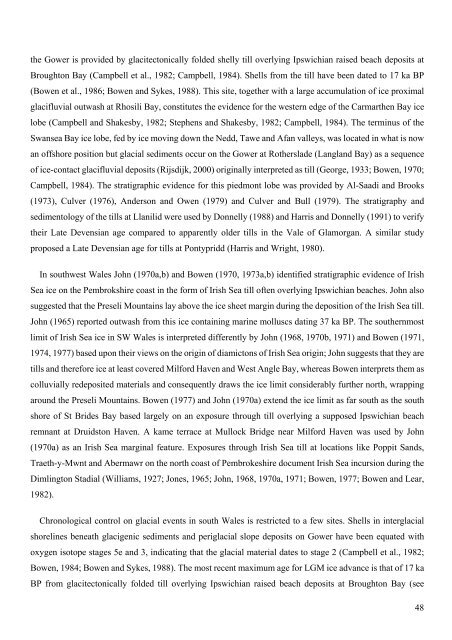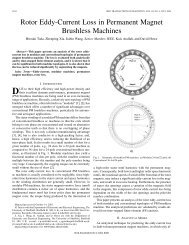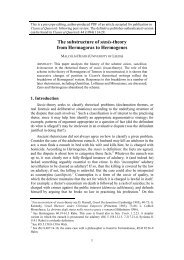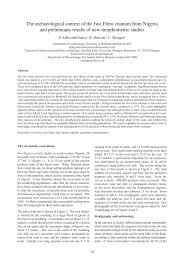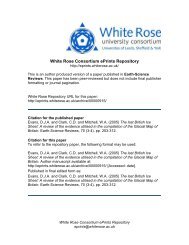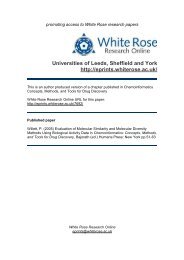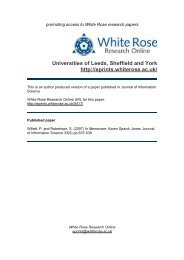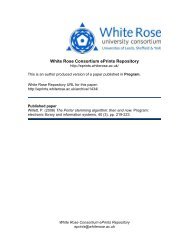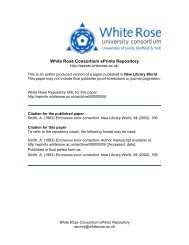The last British Ice Sheet: A review of the evidence utilised in the ...
The last British Ice Sheet: A review of the evidence utilised in the ...
The last British Ice Sheet: A review of the evidence utilised in the ...
Create successful ePaper yourself
Turn your PDF publications into a flip-book with our unique Google optimized e-Paper software.
<strong>the</strong> Gower is provided by glacitectonically folded shelly till overly<strong>in</strong>g Ipswichian raised beach deposits at<br />
Broughton Bay (Campbell et al., 1982; Campbell, 1984). Shells from <strong>the</strong> till have been dated to 17 ka BP<br />
(Bowen et al., 1986; Bowen and Sykes, 1988). This site, toge<strong>the</strong>r with a large accumulation <strong>of</strong> ice proximal<br />
glacifluvial outwash at Rhosili Bay, constitutes <strong>the</strong> <strong>evidence</strong> for <strong>the</strong> western edge <strong>of</strong> <strong>the</strong> Carmar<strong>the</strong>n Bay ice<br />
lobe (Campbell and Shakesby, 1982; Stephens and Shakesby, 1982; Campbell, 1984). <strong>The</strong> term<strong>in</strong>us <strong>of</strong> <strong>the</strong><br />
Swansea Bay ice lobe, fed by ice mov<strong>in</strong>g down <strong>the</strong> Nedd, Tawe and Afan valleys, was located <strong>in</strong> what is now<br />
an <strong>of</strong>fshore position but glacial sediments occur on <strong>the</strong> Gower at Ro<strong>the</strong>rslade (Langland Bay) as a sequence<br />
<strong>of</strong> ice-contact glacifluvial deposits (Rijsdijk, 2000) orig<strong>in</strong>ally <strong>in</strong>terpreted as till (George, 1933; Bowen, 1970;<br />
Campbell, 1984). <strong>The</strong> stratigraphic <strong>evidence</strong> for this piedmont lobe was provided by Al-Saadi and Brooks<br />
(1973), Culver (1976), Anderson and Owen (1979) and Culver and Bull (1979). <strong>The</strong> stratigraphy and<br />
sedimentology <strong>of</strong> <strong>the</strong> tills at Llanilid were used by Donnelly (1988) and Harris and Donnelly (1991) to verify<br />
<strong>the</strong>ir Late Devensian age compared to apparently older tills <strong>in</strong> <strong>the</strong> Vale <strong>of</strong> Glamorgan. A similar study<br />
proposed a Late Devensian age for tills at Pontypridd (Harris and Wright, 1980).<br />
In southwest Wales John (1970a,b) and Bowen (1970, 1973a,b) identified stratigraphic <strong>evidence</strong> <strong>of</strong> Irish<br />
Sea ice on <strong>the</strong> Pembrokshire coast <strong>in</strong> <strong>the</strong> form <strong>of</strong> Irish Sea till <strong>of</strong>ten overly<strong>in</strong>g Ipswichian beaches. John also<br />
suggested that <strong>the</strong> Preseli Mounta<strong>in</strong>s lay above <strong>the</strong> ice sheet marg<strong>in</strong> dur<strong>in</strong>g <strong>the</strong> deposition <strong>of</strong> <strong>the</strong> Irish Sea till.<br />
John (1965) reported outwash from this ice conta<strong>in</strong><strong>in</strong>g mar<strong>in</strong>e molluscs dat<strong>in</strong>g 37 ka BP. <strong>The</strong> sou<strong>the</strong>rnmost<br />
limit <strong>of</strong> Irish Sea ice <strong>in</strong> SW Wales is <strong>in</strong>terpreted differently by John (1968, 1970b, 1971) and Bowen (1971,<br />
1974, 1977) based upon <strong>the</strong>ir views on <strong>the</strong> orig<strong>in</strong> <strong>of</strong> diamictons <strong>of</strong> Irish Sea orig<strong>in</strong>; John suggests that <strong>the</strong>y are<br />
tills and <strong>the</strong>refore ice at least covered Milford Haven and West Angle Bay, whereas Bowen <strong>in</strong>terprets <strong>the</strong>m as<br />
colluvially redeposited materials and consequently draws <strong>the</strong> ice limit considerably fur<strong>the</strong>r north, wrapp<strong>in</strong>g<br />
around <strong>the</strong> Preseli Mounta<strong>in</strong>s. Bowen (1977) and John (1970a) extend <strong>the</strong> ice limit as far south as <strong>the</strong> south<br />
shore <strong>of</strong> St Brides Bay based largely on an exposure through till overly<strong>in</strong>g a supposed Ipswichian beach<br />
remnant at Druidston Haven. A kame terrace at Mullock Bridge near Milford Haven was used by John<br />
(1970a) as an Irish Sea marg<strong>in</strong>al feature. Exposures through Irish Sea till at locations like Poppit Sands,<br />
Traeth-y-Mwnt and Abermawr on <strong>the</strong> north coast <strong>of</strong> Pembrokeshire document Irish Sea <strong>in</strong>cursion dur<strong>in</strong>g <strong>the</strong><br />
Diml<strong>in</strong>gton Stadial (Williams, 1927; Jones, 1965; John, 1968, 1970a, 1971; Bowen, 1977; Bowen and Lear,<br />
1982).<br />
Chronological control on glacial events <strong>in</strong> south Wales is restricted to a few sites. Shells <strong>in</strong> <strong>in</strong>terglacial<br />
shorel<strong>in</strong>es beneath glacigenic sediments and periglacial slope deposits on Gower have been equated with<br />
oxygen isotope stages 5e and 3, <strong>in</strong>dicat<strong>in</strong>g that <strong>the</strong> glacial material dates to stage 2 (Campbell et al., 1982;<br />
Bowen, 1984; Bowen and Sykes, 1988). <strong>The</strong> most recent maximum age for LGM ice advance is that <strong>of</strong> 17 ka<br />
BP from glacitectonically folded till overly<strong>in</strong>g Ipswichian raised beach deposits at Broughton Bay (see<br />
48


